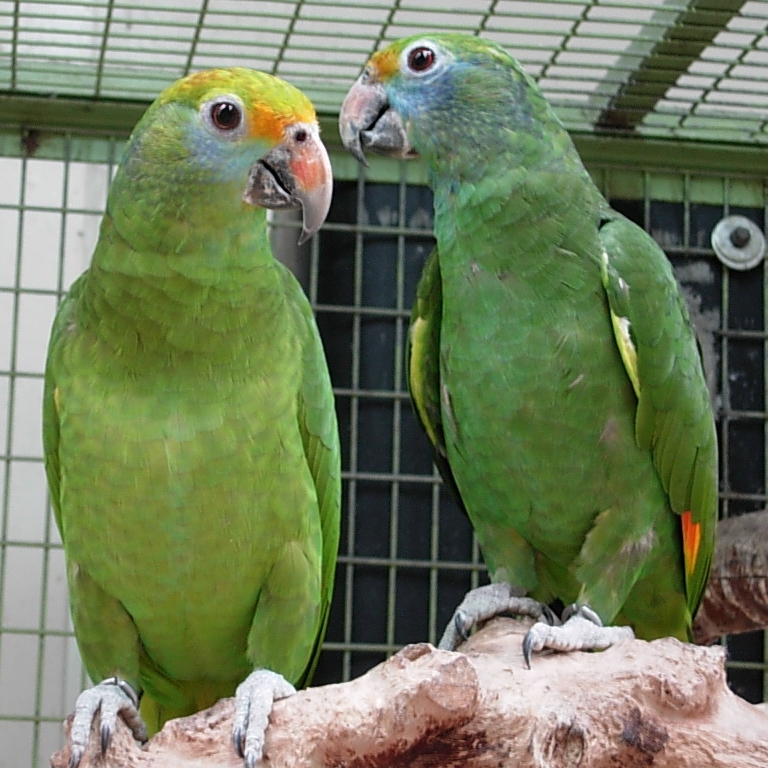|
Orange-fronted Parakeet
The orange-fronted parakeet or orange-fronted conure (''Eupsittula canicularis''), also known as the half-moon conure, is a medium-sized parrot that is resident from western Mexico to Costa Rica. Taxonomy The orange-fronted parakeet was Species description, formally described in 1758 by the Swedish naturalist Carl Linnaeus in the 10th edition of Systema Naturae, tenth edition of his ''Systema Naturae''. He placed it with all the other parrots in the genus ''Psittacus'' and coined the binomial nomenclature, binomial name ''Psittacus canicularis''. The type locality (biology), type locality is northwestern Costa Rica. Linnaeus based his description on the "red and blue-headed parakeet" that had been described and illustrated in 1751 by the English naturalist George Edwards (naturalist), George Edwards in the fourth part of his ''A Natural History of Common Birds''. The orange-fronted parakeet is now one of five species placed in the genus ''Eupsittula'' that was introduced in 1853 ... [...More Info...] [...Related Items...] OR: [Wikipedia] [Google] [Baidu] |
Carl Linnaeus
Carl Linnaeus (; 23 May 1707 – 10 January 1778), also known after his ennoblement in 1761 as Carl von Linné Blunt (2004), p. 171. (), was a Swedish botanist, zoologist, taxonomist, and physician who formalised binomial nomenclature, the modern system of naming organisms. He is known as the "father of modern taxonomy". Many of his writings were in Latin; his name is rendered in Latin as and, after his 1761 ennoblement, as . Linnaeus was born in Råshult, the countryside of Småland, in southern Sweden. He received most of his higher education at Uppsala University and began giving lectures in botany there in 1730. He lived abroad between 1735 and 1738, where he studied and also published the first edition of his ' in the Netherlands. He then returned to Sweden where he became professor of medicine and botany at Uppsala. In the 1740s, he was sent on several journeys through Sweden to find and classify plants and animals. In the 1750s and 1760s, he continued to collect an ... [...More Info...] [...Related Items...] OR: [Wikipedia] [Google] [Baidu] |
Sirius
Sirius is the list of brightest stars, brightest star in the night sky. Its name is derived from the Ancient Greek language, Greek word , or , meaning 'glowing' or 'scorching'. The star is designated α Canis Majoris, Latinisation of names, Latinized to Alpha Canis Majoris, and abbreviated Alpha CMa or α CMa. With a visual apparent magnitude of −1.46, Sirius is almost twice as bright as Canopus, the next brightest star. Sirius is a binary star consisting of a main-sequence star of spectral type A-type main-sequence star, A0 or A1, termed Sirius A, and a faint white dwarf companion of spectral type DA2, termed Sirius B. The distance between the two varies between 8.2 and 31.5 astronomical units as they orbit every 50 years. Sirius appears bright because of its intrinsic luminosity and its proximity to the Solar System. At a distance of , the Sirius system is one of Earth's List of nearest stars, nearest neighbours. Sirius is gradually moving closer to the Solar S ... [...More Info...] [...Related Items...] OR: [Wikipedia] [Google] [Baidu] |
Unihemispheric Slow-wave Sleep
Unihemispheric slow-wave sleep (USWS) is sleep where one half of the brain rests while the other half remains alert. This is in contrast to normal sleep where both eyes are shut and both halves of the brain show unconsciousness. In USWS, also known as asymmetric slow-wave sleep, one half of the brain is in deep sleep, a form of non-rapid eye movement sleep and the eye corresponding to this half is closed while the other eye remains open. When examined by low-voltage electroencephalography (EEG), the characteristic slow-wave sleep tracings are seen from one side while the other side shows a characteristic tracing of wakefulness. The phenomenon has been observed in a number of terrestrial, aquatic and avian species. Unique physiology, including the differential release of the neurotransmitter acetylcholine, has been linked to the phenomenon. USWS offers a number of benefits, including the ability to rest in areas of high predation or during long migratory flights. The behaviour remai ... [...More Info...] [...Related Items...] OR: [Wikipedia] [Google] [Baidu] |
International Parrot Trade
The international trade in parrots is a lucrative enterprise, and forms an important part of the international wildlife trade. As parrots have become increasingly endangered, many countries have placed restrictions on the trade and/or prohibited the trade altogether. Despite the restriction on trade in many countries however, the market still operates both legally and illegally. Approximately 2,600 of the more than 9,600 bird species in existence are subject to trade, FAO. 2011. Trade in Wild Birds and Related Bird Movements in Latin America and the Caribbean' Animal Production and Health Paper No. 166. Rome. and 20% of these species belong to the order Psittaciformes (parrots). In 2009, 3.9% of households in the United States owned birds, which equated to 11,199,000 pet birds in total, and 75% of these belonged to the Psittaciforme order. International trade Top exporters The greatest number of parrots came from Latin American countries (mostly Guyana, Suriname and Argentin ... [...More Info...] [...Related Items...] OR: [Wikipedia] [Google] [Baidu] |
Companion Parrot
A companion parrot is a parrot kept as a pet that interacts abundantly with its human counterpart. Generally, most species of parrot can make excellent companions, but must be carefully managed around other common pet species like dogs and cats as they might be hostile towards them. Species of parrots that are kept as companions include large parrots, such as amazons, greys, cockatoos, eclectus, hawk-headed parrots, and macaws; (Species include hybrids like the Catalina macaw) mid-sized birds, such as caiques, conures, quakers, ''Pionus'', ''Poicephalus'', rose-ringed parakeets, and rosellas; and many of the smaller types, including ''Brotogeris'', budgies, cockatiels, parakeets, lovebirds, parrotlets and lineolated parakeets. Some species of lories and lorikeets are kept as pets but are quite messy, and often more popular as aviary birds. Hanging parrots and fig parrots are normally kept as aviary birds and not as pets. Some species as pygmy parrots and kakapos, night par ... [...More Info...] [...Related Items...] OR: [Wikipedia] [Google] [Baidu] |
Woodpecker
Woodpeckers are part of the bird family Picidae, which also includes the piculets, wrynecks, and sapsuckers. Members of this family are found worldwide, except for Australia, New Guinea, New Zealand, Madagascar, and the extreme polar regions. Most species live in forests or woodland habitats, although a few species are known that live in treeless areas, such as rocky hillsides and deserts, and the Gila woodpecker specialises in exploiting cacti. Members of this family are chiefly known for their characteristic behaviour. They mostly forage for insect prey on the trunks and branches of trees, and often communicate by drumming with their beaks, producing a reverberatory sound that can be heard at some distance. Some species vary their diet with fruits, birds' eggs, small animals, tree sap, human scraps, and carrion. They usually nest and roost in holes that they excavate in tree trunks, and their abandoned holes are of importance to other cavity-nesting birds. They sometimes com ... [...More Info...] [...Related Items...] OR: [Wikipedia] [Google] [Baidu] |
Nasutitermes
''Nasutitermes'' is a genus of termites with a tropical distribution world-wide. Species The ''Termite Catalogue'' lists the following: # '' Nasutitermes acajutlae'' # '' Nasutitermes acangussu'' # '' Nasutitermes acutus'' # '' Nasutitermes aduncus'' # '' Nasutitermes alticola'' # '' Nasutitermes amboinensis'' # '' Nasutitermes anamalaiensis'' # '' Nasutitermes anjiensis'' # '' Nasutitermes anoniensis'' # '' Nasutitermes aquilinus'' # '' Nasutitermes araujoi'' # '' Nasutitermes arborum'' # '' Nasutitermes arenarius'' # '' Nasutitermes aruensis'' # '' Nasutitermes atripennis'' # '' Nasutitermes balingtauagensis'' # ''Nasutitermes banksi'' # '' Nasutitermes bannaensis'' # '' Nasutitermes bashanensis'' # '' Nasutitermes benjamini'' # ''Nasutitermes bikpelanus'' # '' Nasutitermes bivalens'' # ''Nasutitermes boengiensis'' # ''Nasutitermes boetoni'' # ''Nasutitermes bolivari'' # ''Nasutitermes bolivianus'' # ''Nasutitermes brachynasutus'' # ''Nasutitermes brevioculatus'' # ''Nasutit ... [...More Info...] [...Related Items...] OR: [Wikipedia] [Google] [Baidu] |
Termite
Termites are small insects that live in colonies and have distinct castes (eusocial) and feed on wood or other dead plant matter. Termites comprise the infraorder Isoptera, or alternatively the epifamily Termitoidae, within the order Blattodea (along with cockroaches). Termites were once classified in a separate order from cockroaches, but recent phylogenetic studies indicate that they evolved from cockroaches, as they are deeply nested within the group, and the sister group to wood eating cockroaches of the genus ''Cryptocercus''. Previous estimates suggested the divergence took place during the Jurassic or Triassic. More recent estimates suggest that they have an origin during the Late Jurassic, with the first fossil records in the Early Cretaceous. About 3,106 species are currently described, with a few hundred more left to be described. Although these insects are often called "white ants", they are not ants, and are not closely related to ants. Like ants and some bees a ... [...More Info...] [...Related Items...] OR: [Wikipedia] [Google] [Baidu] |
Egg (biology)
An egg is an organic vessel grown by an animal to carry a possibly fertilized egg cell (a zygote) and to incubate from it an embryo within the egg until the embryo has become an animal fetus that can survive on its own, at which point the animal hatches. Most arthropods such as insects, vertebrates (excluding live-bearing mammals), and mollusks lay eggs, although some, such as scorpions, do not. Reptile eggs, bird eggs, and monotreme eggs are laid out of water and are surrounded by a protective shell, either flexible or inflexible. Eggs laid on land or in nests are usually kept within a warm and favorable temperature range while the embryo grows. When the embryo is adequately developed it hatches, i.e., breaks out of the egg's shell. Some embryos have a temporary egg tooth they use to crack, pip, or break the eggshell or covering. The largest recorded egg is from a whale shark and was in size. Whale shark eggs typically hatch within the mother. At and up to , the o ... [...More Info...] [...Related Items...] OR: [Wikipedia] [Google] [Baidu] |
Ficus
''Ficus'' ( or ) is a genus of about 850 species of woody trees, shrubs, vines, epiphytes and hemiepiphytes in the family Moraceae. Collectively known as fig trees or figs, they are native throughout the tropics with a few species extending into the semi-warm temperate zone. The common fig (''F. carica'') is a temperate species native to southwest Asia and the Mediterranean region (from Afghanistan to Portugal), which has been widely cultivated from ancient times for its fruit, also referred to as figs. The fruit of most other species are also edible though they are usually of only local economic importance or eaten as bushfood. However, they are extremely important food resources for wildlife. Figs are also of considerable cultural importance throughout the tropics, both as objects of worship and for their many practical uses. Description ''Ficus'' is a pantropical genus of trees, shrubs, and vines occupying a wide variety of ecological niches; most are evergreen, bu ... [...More Info...] [...Related Items...] OR: [Wikipedia] [Google] [Baidu] |
Pacific
The Pacific Ocean is the largest and deepest of Earth's five oceanic divisions. It extends from the Arctic Ocean in the north to the Southern Ocean (or, depending on definition, to Antarctica) in the south, and is bounded by the continents of Asia and Oceania in the west and the Americas in the east. At in area (as defined with a southern Antarctic border), this largest division of the World Ocean—and, in turn, the hydrosphere—covers about 46% of Earth's water surface and about 32% of its total surface area, larger than Earth's entire land area combined .Pacific Ocean . '' Britannica Concise.'' 2008: Encyclopædia Britannica, Inc. The centers of both the |









.jpg)